|
(11) | EP 0 293 942 A2 |
| (12) | EUROPEAN PATENT APPLICATION |
|
|
|
|
|||||||||||||||||||||||||||
| (54) | Liquid crystal composition containing a pleochroic azo type compound |
| (57) A liquid crystal composition suitable for a guest-host liquid crystal device and
the composition comprises a solution of a liquid crystal substance and a pleochroic
dye which comprises at least one azo type compound having the formula (I),
wherein R¹ represents a hydrogen atom; an alkyl group or an alkoxy group each of which may be substituted by an alkoxy or an aryl group; a cyclohexyl group which may be substituted by an alkyl group; or -COOR³ (wherein R³ represents an alkyl group which may be substituted by an alkoxy group, a cyclohexyl group which may be substituted by an alkyl group, or an aryl group which may be substituted by an alkoxy or an alkyl group); R² represents where R⁴ and R⁵ each represents an alkyl group which may be substituted by an alkoxy or an aryl group; or R⁴ and R⁵ may be connected to each other to form a ring; Z¹ and Z² each represents a hydrogen atom, a halogen atom, an alkyl group or an alkoxy group, or Z¹ and Z² may be connected to each other to form a carbocyclic ring or a nitrogenous heterocyclic ring; m is 1 or 2; and n is 0 or 1. |
[0001] This invention relates to a guest-host liquid crystal composition containing a pleochroic azo type compound.
[0002] There has so far been known to effect color display in utilization of the guest-host effect between a dye and liquid crystal by interposing between a pair of mutually opposing electrodes a liquid crystal composition prepared by dissolving a dye into liquid crystal.
[0003] The dye to be used for such liquid crystal composition is required to have, among other things, high dichroic ratio, high solubility to the liquid crystal, and other properties.
[0004] However, these conventionally known azo type compounds did not always satisfy the properties which are required of the dye to be used in the liquid crystal composition as mentioned above.
[0005] The object of this invention is, therefore to provide guest-host liquid crystal compositions compris ing an azo type compound satisfying the above-described factors.
[0006] With a view to attaining such objective, the present inventors conducted repeated studies and researches, as the result of which they have come to a finding that, the azo type compounds which are represented by the following formula (I), exhibit high dichroic ratio and good solubility to liquid crystal, and that liquid crystal compositions containing such dye perform satisfactory color display. Based on this finding, they have arrived at the present invention.
[0007] Therefore, this invention has its gist in providing liquid crystal compositions containing azo type compounds, which are represented by the following formula (I),
wherein R¹ represents a hydrogen atom, an alkyl group which may be substituted by an alkoxy or aryl group, an alkoxy group which may be substituted by an alkoxy or aryl group, a cyclohexyl group which may be substituted by an alkyl group, or R³OOC- (where R³ represents an alkyl group which may be substituted by an alkoxy group, a cyclohexyl group which may be substituted by an alkyl group, or an aryl group which may be substituted by an alkoxy or alkyl group); R₂ represents
(where R⁴ and R⁵ each represents an alkyl group which may be substituted by an alkoxy or aryl group, and R⁴ and R⁵ optionally connect each other to form a ring); Z¹ and Z² each represents a hydrogen atom, a halogen atom, an alkyl group or an alkoxy group and may connect each other to form a carbocyclic ring or a nitrogenous heterocyclic ring; m represents 1 or 2; and n represents 0 or 1).
[0010] In the azo type compounds represented by the general formula (I) in the present invention, R¹ may be selected from among the following: a hydrogen atom; a linear or branched alkyl group (preferably an alkyl group having 1 to 8 carbon atoms); a linear or branched alkoxy group (preferably an alkoxy group having 1 to 8 carbon atoms); an alkyl group (preferably an alkyl group having 1 to 8 carbon atoms) and an alkoxy group (preferably an alkoxy group having 1 to 8 carbon atoms) which are substituted by an alkoxy group (preferably an alkoxy group having 1 to 8 carbon atoms); an alkyl group (preferably an alkyl group having 1 to 3 carbon atoms) and an alkoxy group (preferably an alkyl group having 1 to 3 carbon atoms) which are substituted by an aryl group such as a phenyl group which may be substituted by an alkyl group having 1 to 8 carbon atoms, an alkoxy group having 1 to 8 carbon atoms or a halogen atom such as a chlorine atom; a cyclohexyl group which may be substituted by an alkyl group having 1 to 8 carbon atoms; and -COOR³ [where R³ is an alkyl group (preferably an alkyl group having 1 to 8 carbon atoms) which may be substituted by an alkoxy group (preferably an alkoxy group having 1 to 8 carbon atoms), a cyclohexyl group which may be substituted by an alkyl group (preferably an alkyl group having 1 to 8 carbon atoms), or an aryl group such as a phenyl or naphthyl group which may be substituted by an alkyl group (preferably an alkyl group having 1 to 8 carbon atoms) or an alkoxy group (preferably an alkoxy group having 1 to 8 carbon atoms)].
[0011] In the general formula (I), substituents R⁴ and R⁵ each represents an alkyl group which may be substituted by an alkoxy or aryl group and each of them may be exemplified by the following: an alkyl group having 1 to 8 carbon atoms; an alkyl group having 1 to 3 carbon atoms which is substituted by an alkoxy group having 1 to 8 carbon atoms; and an alkyl group having 1 to 3 carbon atoms which is substituted by
(where R⁶ is a hydrogen atom, an alkyl group having 1 to 8 carbon atoms, an alkoxy group, or a halogen atom such as a chlorine atom). If desired, R⁴ and R⁵ may connect each other to form a nitrogenous heterocyclic ring such as a piperidine ring, a pyrrolidine ring, a piperazine ring, or a morpholine ring.
[0012] In formula (I), substituents Z¹ and Z² each represents a hydrogen atom, an alkyl group such as an alkyl group having 1 to 3 carbon atoms, an alkoxy group such as an alkoxy group having 1 to 3 carbon atoms, or a halogen atom such as a chlorine atom; Z¹ and Z² may connect each other to form a carbocyclic ring such as a benzene ring, a cyclohexane ring or a nitrogenous heterocyclic ring such as a pyridine ring.
[0013] The azo type compounds suitable for use in the present invention may be illustrated by:
(i) azo type compounds of the following general formula (II) where n=1 in formula
(I):
[where R¹, R², Z¹, Z² and m are the same as defined in formula (I)]; and
(ii) azo type compounds of the following general formula (III) where n=0 in formula
(I):
[where R¹, R², Z¹, Z² and m are the same as defined in formula (I)].
[0014] Azo type compounds that are particularly suitable for use in the liquid crystal composition of the present invention are described hereinafter.
[0015] Among the azo type compounds represented by the general formula (I), particularly preferred are those which are represented by the following general formula (IV):
wherein R¹ has the same meaning as defined in formula (I) and is preferably selected from among: (i) an alkyl group optionally substituted by an alkoxy or aryl group; (ii) an alkoxy group optionally substituted by an alkoxy or aryl group; (iii) a cyclohexyl group optionally substituted by an alkyl group. Preferably, R¹ is (i) or (iii), the former being an alkyl group which may be substituted by an aryl group. An alkyl group or a 4-alkylcyclohexyl group is particularly preferred as R¹.
[0016] While R² has the same meaning as defined in formula (I), it is preferably
(where R⁴ and R⁵ each represents an alkyl group which may be substituted by an alkoxy or aryl group). More preferably, R⁵ represents
(where R⁷ is a hydrogen atom or an alkyl group, and R⁶ is a hydrogen atom, an alkyl group or an alkoxy group) or
(where R⁴ and R⁵ each represents an alkyl group which may be substituted by an alkoxy group), with R⁴ and R⁵ being preferably an alkyl group.
[0017] More preferably, R² is represented by
(where R⁶ represents an alkyl group or an alkoxy group) or
the former being particularly preferred.
[0018] In formula (IV),
Z³ represents a hydrogen atom or an alkyl group, with a hydrogen atom or a methyl group being preferred.
[0019] In formula (IV), m represents a number of 1 or 2, and n represents a number of 0 or 1. When m is 1, R¹ preferably represents an alkyl group or a 4-alkylcyclohexyl group, and when m is 2, R¹ preferably represents an alkyl group. From a practical viewpoint, compounds where n=1 are preferred over those where n=0.
[0020] The azo type compounds represented by the general formula (II) may be prepared as follows in accordance with the method described in Japanese Patent Laid-Open No. 38756/83:
diazotizing a monoazo compound represented by the general formula (V):
wherein R¹, m, Z¹ and Z² have the same meanings as defined in the general formula (II); and
coupling the resulting diazo compound with an aniline represented by the general formula (VI):
where R² and
have the same meanings as defined in the general formula (II).
[0021] The azo type compounds represented by the general formula (III) may be prepared by the same procedures as above except that the compound of formula (V) is replaced with the compound represented by the following general formula (VII):
where R¹, Z¹, Z² and m have the same meanings as defined in formula (III).
[0022] The liquid crystal composition of the present invention contains the compound of formula (I) in an amount ranging from 0.01 to 10 wt%, preferably from 0.05 to 3 wt%, of the liquid crystal substance.
[0023] The liquid crystal composition of the present invention is a compound that is to be used in guest-host type liquid-crystal displays. The term "guest-host type" means the incorporation of a dichroic dye (guest) in a liquid-crystal host. Examples of the guest-host type display include a twisted nematic type (TN) display method, a heat writing (HW) display method, and a guest-host display method employing or not employing a polarizing film.
[0024] While various liquid crystals may be used in the liquid crystal composition of the present invention, typical examples include nematic liquid crystals, smectic liquid crystals (e.g. ferroelectric liquid crystals such as smectic A and chiral smectic C structures), cholesteric liquid crystals, and polymer liquid crystals.
[0025] The nematic liquid crystal to be used for the liquid crystal composition according to the present invention may be selected from fairly broad varieties, provided that they are able to exhibit the nematic state within a range of their operating temperatures. It may also be possible that such a nematic liquid crystal is caused to assume the cholesteric state by addition thereto of an optically active substance to be described later. As the nematic liquid crystal, there may be exemplified those substances as shown in No. 1 to No. 3 of the following Table 1 or their derivatives.
[0026] In the above Table 1, Ra denotes an alkyl group or an alkoxy group; Rb denotes an alkyl group; and X represents an alkyl group, an alkoxy group, a nitro group, a cyano group, or a halogen.
[0027] While the host liquid crystal substance to be used for the liquid crystal composition according to the present invention may be selected from any of those liquid crystals shown in Table 1 above or their mixtures, the liquid crystal produced and marketed by Merck & Co. under a tradename of "ZLI-1132"; the liquid crystal produced and marketed by Merck & Co. under a tradename of "ZLI-1565"; and the liquid crystal produced and marketed by British Drug House & Co. under a tradename of "E-7", are recommended as useful.
[0028] As the optically active substances to be used in the liquid crystal composition according to the present invention, there may be exemplified, chiral nematic compounds, for example, those compounds having optically active groups such as a 2-methylbutyl group, a 3-methylbutoxy group, a 3-methylpentyl group, a 3-methylpentoxy group, a 4-methylhexyl group, a 4-methylhexyloxy group, etc. introduced into the nematic liquid crystals; alcohol derivatives disclosed in Japanese Unexamined Patent Publication No. 45546/76 such as ℓ-menthol and d-borneol; ketone derivatives such as d-camphor and 3-methyl cyclohexane; carboxylic acid derivatives such as d-citronellic acid and ℓ-camphoric acid; aldehyde derivatives such as d-citronellal; alkene derivatives such as d-linonene; or other optically active substances such as amines, amides and nitrile derivatives.
[0029] As the elements for performing the liquid crystal display by use of the liquid crystal composition according to the present invention, there may be used known liquid crystal display elements. In more detail, transparent electrodes of any arbitrary patterns are formed on each of two sheets of glass substrates, at least one of which is transparent, and then these two sheets of glass substrates are arranged in parallel relationship such that the surface sides of the glass substrates, on which the electrodes have been formed, may be mutually opposed with appropriate spacers being interposed between them to construct the liquid crystal display element to be used. In this case, a space gap for the element is determined by the spacers. A preferred range of the space gap for the liquid crystal display element may be from 1 to 100 µm, or more preferably from 2 to 50 µm from the practical standpoint.
[0030] The azo type compounds for use in the present invention present violet to blue colors and feature high dichroic ratio and solubility in liquid crystals. Therefore, the liquid crystal composition of the present invention containing such compounds enable high-contrast color display not only in the blue range but also in black color when compounded with other pigments. In addition, the liquid crystal composition of the present invention is very useful in providing quick-response display.
[0031] In the following, the present invention will be explained more concretely in reference to practical examples, although the present invention is not restricted by these examples.
[0032] Here, explaining briefly about the order parameter S for indicating the dichroism, it can be empirically found on any dye from the following equation.
[0033] In the above equation, A// and A┴ respectively denote light absorbances of the dye with respect to light beams which have been polarized in parallel with and perpendicular to, respectively, the direction of orientation of the liquid crystal.
[0034] Specifically, the order parameter S is a value which indicates a display contrast of the guest-host type liquid crystal element, according to which the nearer this value comes theoretically to 1, the less becomes the degree of color remnant in the whitened portion, whereby a clear display of high brightness and contrast can be accomplished.
EXAMPLE 1-1
[0035] The azo type compound (dye) which is represented by the following formula:
was added to the afore-mentioned mixed liquid crystal ZLI-1565 (the tradename of the product of Merck & Co.), and the batch was heated to a temperature of 70°C or higher, followed by agitating the same when it assumed a state of isotropic liquid, after which the mixture was left to cool. These process steps were repeated to well dissolve the above-mentioned compound (dye) into the liquid crystal.
[0036] The thus prepared liquid crystal composition according to the present invention was sealed into a space gap of 10 µm of an element composed of a pair of upper and lower glass substrates, each having a transparent electrode and been subjected to treatment, wherein the surface side of the glass substrate in contact with the liquid crystal was coated with a polyamide type resin, and cured, after which the resin was rubbed to have the homogeneous orientation. The above-mentioned liquid crystal within the element as treated for the above-mentioned homogeneous orientation took that homogeneous orientation when no electric voltage was applied to it, and the molecules of the dye also took the same orientation in accordance with the host liquid crystal.
[0037] The thus fabricated guest-host element was measured for its absorption spectrum by use of light polarized in parallel with the direction of orientation of the liquid crystal molecules, and the light polarized vertically thereto, from which the maximum absorbing wavelength of the dye to each of these polarized lights were found. In finding out the absorbance of the dye, there was made corrections on the absorption by the host liquid crystal and the glass substrates as well as the reflection loss of the element.
[0038] Also, using the absorbances A// and A┴ with respect to each of the polarized lights, the values of the order parameter S were calculated based on the afore-mentioned equation of:
[0040] The azo type compound used in Example 1-1 was prepared by the following procedures: 5 g of 2-amino-5-(4′-n-butyl)phenylazothienothiazole was diazotized with 5.2 g of 43% nitrosyl sulfate at 0°C in a mixed solvent consisting of N-methylpyrrolidone (100 ml), acetic acid (50 ml) and propionic acid (50 ml), and then subjected to coupling reaction with 2.2 g of N-ethyl-N-methylaniline at 0°C. The resulting azo type compound had a melting point of 239 to 240°C.
EXAMPLE 1-2
[0041] An azo type compound represented by the following formula:
was processed as in Example 1-1 to fabricate a liquid crystal composition in guest-host element. The maximum absorption wavelength and order parameter (S) of the dye compound were measured and calculated as in Example 1-1. The results are shown in Table 2 under No. 2.
[0042] The azo type compound used in Example 1-2 was prepared as described in Example 1-1 except that N-ethyl-N-methylaniline was replaced by N-(p-n-pentylbenzyl)-3-methylaniline. This azo type compound had a melting point of 190 to 191°C.
EXAMPLES 1-3 TO 1-33
[0043] Azo type compounds (dyes) of the present invention having the structural formulas shown in Table 2 under Nos. 3 to 33 were prepared and isolated as in Example 1-1. The so prepared 31 dye compounds were processed as in Example 1-1 to fabricate liquid crystal compositions in guest-host element. The maximum absorption wavelengths (λmax) and order parameters (S) of the respective dye compounds were measured and calculated as in Example 1-1. The results are shown in Table 2 under Nos. 3 to 33.
EXAMPLE 2-1
[0044] An azo type compound represented by the following structural formula:
was processed as in Example 1-1 to fabricate a liquid crystal composition in guest-host element. The maximum absorption wavelength and order parameter (S) of the compound were measured and calculated as in Example 1-1. The results are shown in Table 3 under No. 1.
[0045] The azo type compound used in Example 2-1 was prepared by the following procedures: 4.4 g of 2-amino-5-[4˝-(4′-n-pentyl)phenylazo]phenylazothienothiazole was diazotized with 3.5 g of 43% nitrosyl sulfate at 0°C in a mixed solvent consisting of phosphoric acid (200 ml) and acetic acid (40 ml), and then subjected to coupling reaction with 26.5 g of N-(p-n-pentylbenzyl)-3-methylaniline at 0°C. The resulting azo type compound had a melting point of 198 to 199°C. Molecular extinction coefficient measurement in chloroform gave a value of 6.50×10⁴. This shows that the azo type compound of the present invention which was prepared in Example 2-1 had a very great coloring power and needed to be incorporated in only a small amount when preparing a desired liquid crystal composition.
EXAMPLE 2-2
[0046] An azo type compound represented by the formula:
was processed as in Example 1-1 to fabricate a liquid crystal composition in guest-host element. The maximum absorption wavelength and order parameter (S) of the compound were measured and calculated as in Example 1-1. The results are shown in Table 3 under No. 2.
[0047] The azo type compound used in Example 2-2 was prepared as described in Example 2-1 except that 2-amino-5-[4˝-(4′-n-pentyl)phenylazo]phenylazothienothiazole was replaced by 2-amino-5-(4′-phenylazo)phenylazothienothiazole. This azo type compound had a melting point of 213 to 214°C.
[0048] Molecular extinction coefficient measurement of the dye compound in chloroform gave a value of 7.6×10⁴, indicating the great coloring power of this azo type compound.
EXAMPLES 2-3 TO 2-31
[0049] Azo type compounds (dyes) of the present invention having the structural formulas shown in Table 3 under Nos. 3 to 31 were prepared and isolated as in Example 1-1. The so prepared 29 dye compounds were processed as in Example 1-1 to fabricate liquid crystal compositions in guest-host element. The maximum absorption wavelengths (λmax) and order parameters (S) of the respective compounds were measured and calculated as in Example 1-1. The results are shown in Table 3 under Nos. 3 to 31.
1. A liquid crystal composition suitable for a guest-host liquid crystal device which
comprises a solution of a liquid crystal substance and a pleochroic dye which comprises
at least one azo type compound having the formula (I),

wherein R¹ represents a hydrogen atom; an alkyl group or an alkoxy group each of which may be substituted by an alkoxy or an aryl group; a cyclohexyl group which may be substituted by an alkyl group; or -COOR³ (wherein R³ represents an alkyl group which may be substituted by an alkoxy group, a cyclohexyl group which may be substituted by an alkyl group, or an aryl group which may be substituted by an alkoxy or an alkyl group);
R₂ represents
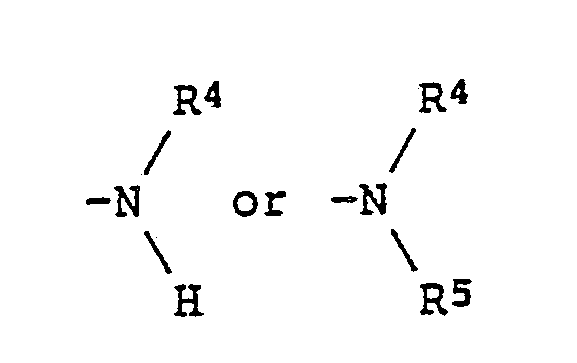
where R⁴ and R⁵ each represents an alkyl group which may be substituted by an alkoxy or an aryl group; or R⁴ and R⁵ may be connected to each other to form a ring;
Z¹ and Z² each represents a hydrogen atom, a halogen atom, an alkyl group or an alkoxy group, or Z¹ and Z² may be connected to each other to form a carbocyclic ring or a nitrogenous heterocyclic ring;
m is 1 or 2; and
n is 0 or 1.
wherein R¹ represents a hydrogen atom; an alkyl group or an alkoxy group each of which may be substituted by an alkoxy or an aryl group; a cyclohexyl group which may be substituted by an alkyl group; or -COOR³ (wherein R³ represents an alkyl group which may be substituted by an alkoxy group, a cyclohexyl group which may be substituted by an alkyl group, or an aryl group which may be substituted by an alkoxy or an alkyl group);
R₂ represents
where R⁴ and R⁵ each represents an alkyl group which may be substituted by an alkoxy or an aryl group; or R⁴ and R⁵ may be connected to each other to form a ring;
Z¹ and Z² each represents a hydrogen atom, a halogen atom, an alkyl group or an alkoxy group, or Z¹ and Z² may be connected to each other to form a carbocyclic ring or a nitrogenous heterocyclic ring;
m is 1 or 2; and
n is 0 or 1.
2. A liquid crystal composition as claimed in Claim 1 wherein the azo type compound
is represented by the following general formula (II):

where R¹, R², Z¹, Z² and m are the same as defined in the general formula (I).
where R¹, R², Z¹, Z² and m are the same as defined in the general formula (I).
3. A liquid crystal composition as claimed in Claim 1 wherein the azo type compound
is represented by the following general formula (III):

where R¹, R², Z¹, Z² and m are the same as defined in the general formula (I).
where R¹, R², Z¹, Z² and m are the same as defined in the general formula (I).
4. A liquid crystal composition as claimed in Claim 1 wherein the azo type compound
is represented by the following general formula (IV):

where R¹, R³, m and n are the same as defined in the general formula (I);
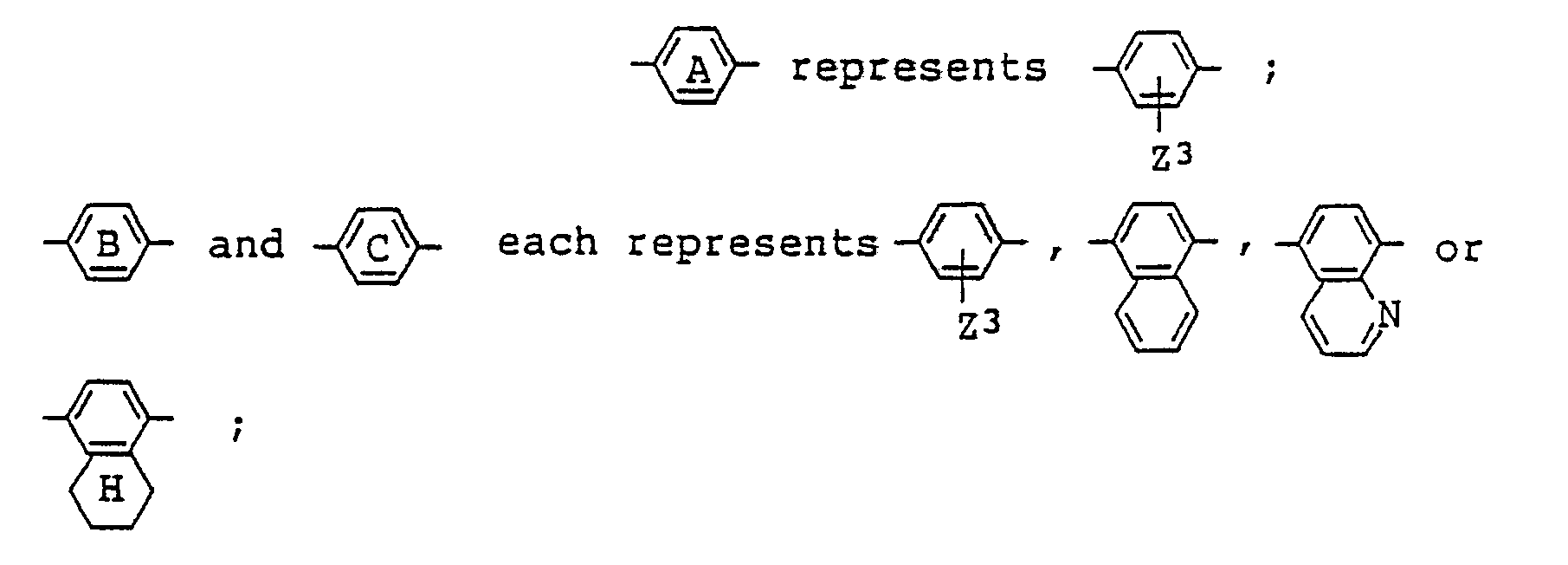
and Z³ represents a hydrogen atom or an alkyl group.
where R¹, R³, m and n are the same as defined in the general formula (I);
and Z³ represents a hydrogen atom or an alkyl group.
5. A liquid crystal composition as claimed in Claim 4 wherein R¹ in the general formula
(IV) for the azo type compound represents a hydrogen atom, an alkyl group which may
be substituted by an alkoxy or aryl group, an alkoxy group which may be substituted
by an alkoxy or aryl group, or a cyclohexyl group which may be substituted by an alkyl
group, R² is such that R⁴ and R⁵ each represents an alkyl group which may be substituted
by an alkoxy or aryl group,

Z³ being the same as defined in Claim 4.
Z³ being the same as defined in Claim 4.
6. A liquid crystal composition as claimed in Claim 4 wherein R¹ in the general formula
(IV) for the azo type compound represents a hydrogen atom, an alkyl group which may
be substituted by an alkoxy or aryl group, or a cyclohexyl group which may be substituted
by an alkyl group,

Z³ being the same as defined in Claim 4.
Z³ being the same as defined in Claim 4.
7. A liquid crystal composition as claimed in Claim 4 wherein R² in the general formula
(IV) for the azo type compound represents

(where R⁶ represents a hydrogen atom or an alkyl group, and R⁷ represents a hydrogen atom, an alkyl group or an alkoxy group) or
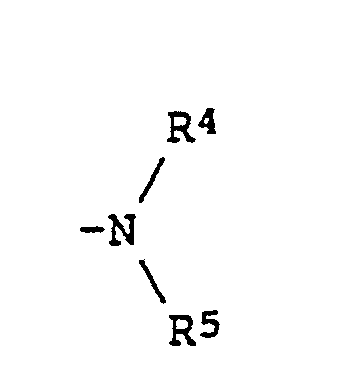
(where R⁴ and R⁵ each represents an alkyl group which may be substituted by an alkoxy group).
(where R⁶ represents a hydrogen atom or an alkyl group, and R⁷ represents a hydrogen atom, an alkyl group or an alkoxy group) or
(where R⁴ and R⁵ each represents an alkyl group which may be substituted by an alkoxy group).
8. A liquid crystal composition as claimed in Claim 4 wherein R¹ in the general formula
(IV) for the azo type compound represents an alkyl group which may be substituted
by an aryl group or a cyclohexyl group which may be substituted by an alkyl group;
and Z³ represents a hydrogen atom or a methyl group.
9. A liquid crystal composition as claimed in Claim 7 wherein R¹ in the general formula
(IV) for the azo type compound represents an alkyl group or a 4-alkylcyclohexyl group;
R² is such that R⁶ represents an alkyl group or an alkoxy group, R⁷ representing a
hydrogen atom, and R⁴ and R⁵ each representing an alkyl group;
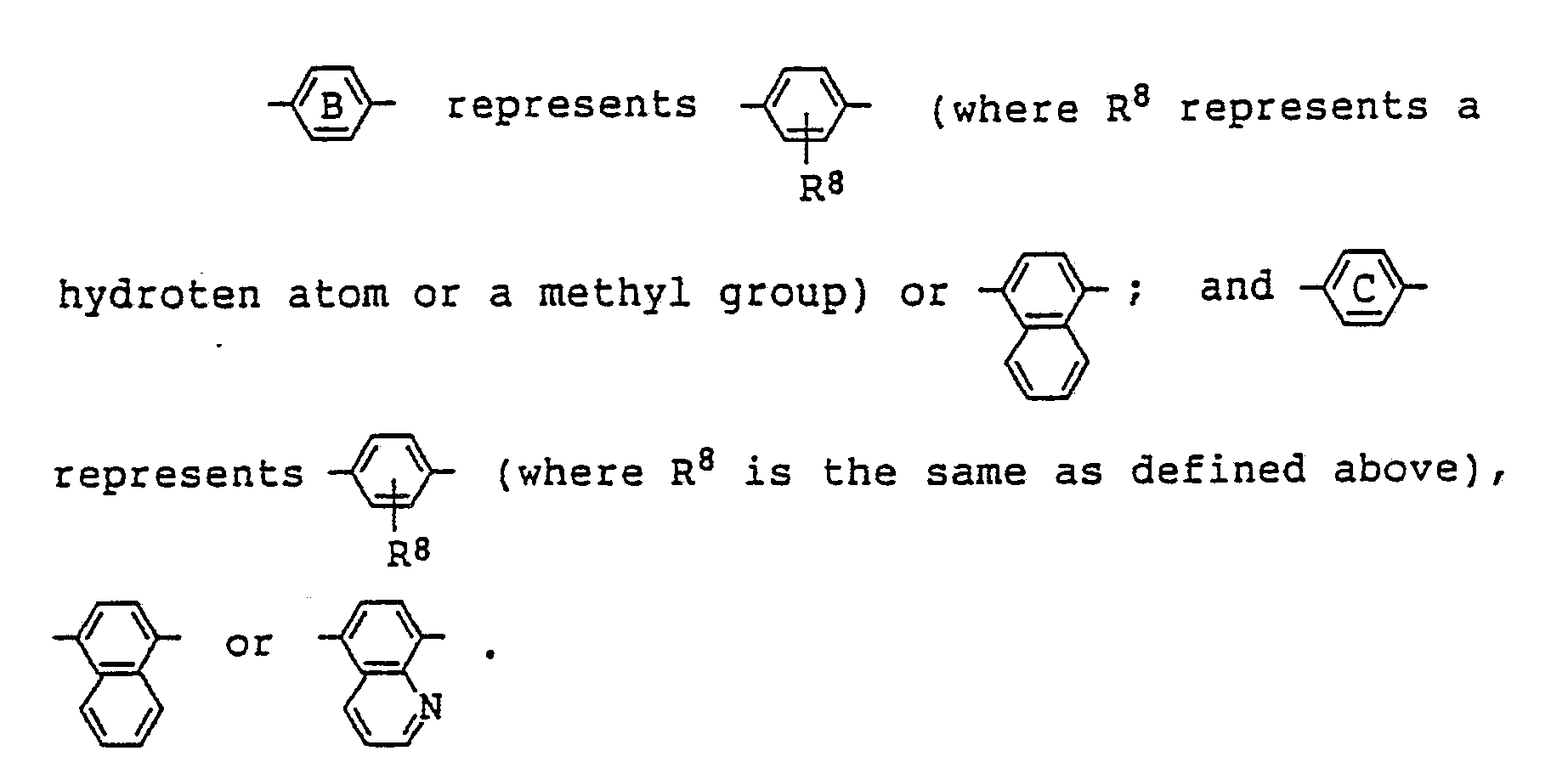
10. A liquid crystal composition as claimed in Claim 4 wherein m in the general formula
(IV) for the azo type compound is 1, and R¹ represents an alkyl group or a 4-alkylcyclohexyl
group.
11. A liquid crystal composition as claimed in Claim 4 wherein m in the general formula
(IV) for the azo type compound is 2 and R¹ represents an alkyl group.
12. A liquid crystal composition as claimed in Claim 7 wherein R² in the general formula
(IV) for the azo type compound represents
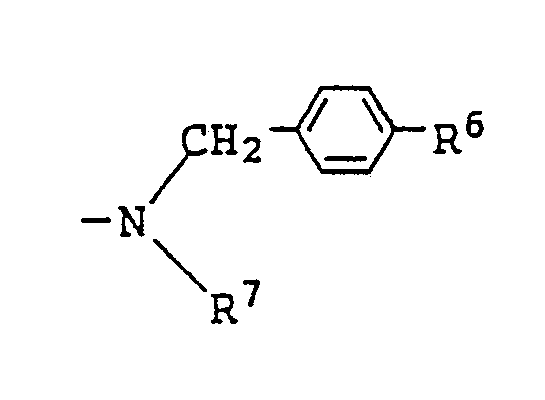
(where R⁶ is the same as defined in Claim 7).
(where R⁶ is the same as defined in Claim 7).
13. A liquid crystal composition as claimed in Claim 9 wherein

in the general formula (IV) for the azo type compound represents
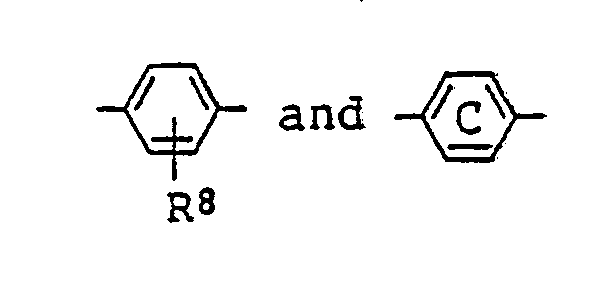
represents
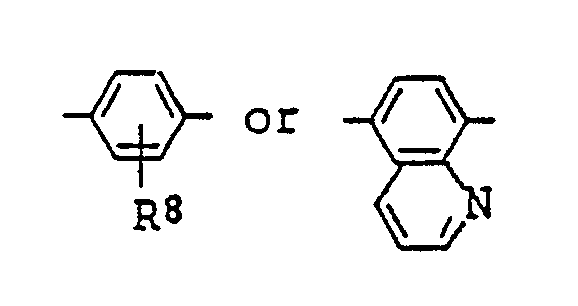
(where R⁸ is the same as defined in Claim 9).
in the general formula (IV) for the azo type compound represents
represents
(where R⁸ is the same as defined in Claim 9).
14. A liquid crystal composition as claimed in Claim 9 wherein
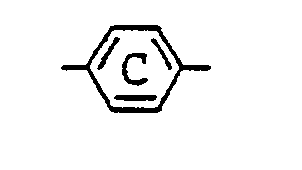
in the general formula (IV) for the azo type compound represents

(where R⁸ is the same as defined in Claim 9).
in the general formula (IV) for the azo type compound represents
(where R⁸ is the same as defined in Claim 9).
15. A liquid crystal composition as claimed in Claim 4 wherein n in the general formula
(IV) for the azo type compound is 1.
16. A liquid crystal composition as claimed in Claim 1 wherein R¹ in the general formula
(I) for the azo type compound represents a hydrogen atom; a linear or branched C₁₋₈
alkyl group; a linear or branched C₁₋₈ alkoxy group; a C₁₋₈ alkyl or alkoxy group
substituted by a C₁₋₈ alkoxy group; a C₁₋₃ alkyl and alkoxy group which are substituted
by a phenyl group which may be substituted by a C₁₋₈ alkyl group, a C₁₋₈ alkoxy group
or a halogen atom; a cyclohexyl group which may be substituted by a C₁₋₈ alkyl group;
or -COOR³ (where R³ represents a C₁₋₈ alkyl group which may be substituted by a C₁₋₈
alkoxy group, a cyclohexyl group which may be substituted by a C₁₋₈ alkyl group, or
a phenyl or naphthyl group which may be substituted by a C₁₋₈ alkyl or alkoxy group).
17. A liquid crystal composition as claimed in Claim 1 wherein R² in the general formula
(I) for the azo type compound is such that substituent R⁴ and R⁵ each represents a
C₁₋₈ alkyl group, a C₁₋₃ alkyl group substituted by a C₁₋₈ alkoxy group, or a C₁₋₃
alkyl group substituted by
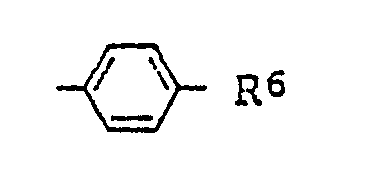
(where R⁶ represents a hydrogen atom, a C₁₋₈ alkyl group, a C₁₋₈ alkoxy group, or a halogen atom), and R⁴ and R⁵ optionally connecting each other to form a piperidine ring, a pyrrolidine ring, a piperazine ring or a morpholine ring.
(where R⁶ represents a hydrogen atom, a C₁₋₈ alkyl group, a C₁₋₈ alkoxy group, or a halogen atom), and R⁴ and R⁵ optionally connecting each other to form a piperidine ring, a pyrrolidine ring, a piperazine ring or a morpholine ring.
18. A liquid crystal composition as claimed in Claim 1 wherein Z¹ and Z² in the general
formula (I) for the azo type compound each represents a C₁₋₃ alkyl group, a C₁₋₃ alkoxy
group, a chlorine atom, or Z¹ and Z² may connect each other to form a benzene ring,
a cyclohexane ring or a pyridine ring.
19. A liquid crystal composition as claimed in Claim 1 wherein the azo type compound
is incorporated in an amount of 0.01 to 10 wt% of the liquid crystal substance.
20. A liquid crystal composition as claimed in Claim 1 wherein the azo type compound
is incorporated in an amount of 0.05 to 3 wt% of the liquid crystal substance.
